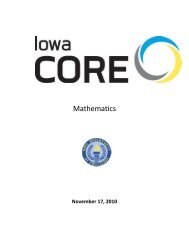The Arc's Self-Determination Scale: Procedural Guidelines
The Arc's Self-Determination Scale: Procedural Guidelines
The Arc's Self-Determination Scale: Procedural Guidelines
Create successful ePaper yourself
Turn your PDF publications into a flip-book with our unique Google optimized e-Paper software.
pervasive, if not clearly articulated, mistrust of self-report<br />
measures with people with mental retardation based on<br />
several factors. Practitioners and researchers have tended<br />
to dismiss personal reports from such individuals as<br />
unreliable. Individuals with mental retardation were seen<br />
as intellectually incompetent and this incompetence<br />
extended to the individuals’ reports of beliefs, emotions,<br />
feelings, or perceptions. <strong>The</strong>ir opinions and perceptions<br />
were not accorded value and worth and were not solicited<br />
or encouraged (p. 528).<br />
Within a competence model of disability, however, the beliefs,<br />
opinions and perceptions of people with disabilities become<br />
“increasingly important and valued, not imbued with assumptions<br />
of incompetence” (Wehmeyer, 1994a). Difficulties in<br />
measurement remain, but the importance of individuals’ beliefs<br />
about themselves and their environments make the effort<br />
worthwhile.<br />
<strong>The</strong> limited research that exists suggests that people with<br />
disabilities hold perceptions of control that are more external, and<br />
thus more maladaptive, than non-disabled peers. Students with<br />
learning disabilities (Dudley-Marling, Snider & Tarver, 1982) and<br />
mental retardation (Wehmeyer, 1994b) have been found to have<br />
more external scores than non-disabled peers, even when<br />
compared to same age peers who experienced school failure but<br />
were not receiving special education services. Such maladaptive<br />
perceptions were found to contribute to ineffective career decisionmaking<br />
for youth with mental retardation and learning disabilities<br />
(Wehmeyer, 1993). Wehmeyer (1994c) also found that adults with<br />
cognitive and developmental disabilities who were competitively<br />
employed held significantly more adaptive or internal perceptions<br />
of control than did peers who worked in sheltered environments or<br />
who were unemployed.<br />
<strong>The</strong> role of educators in promoting internal perceptions of<br />
control, as well as adaptive efficacy and outcome expectations, a<br />
positive self-awareness and a realistic self-knowledge, is more<br />
complex than just providing adequate instructional experiences.<br />
An internal locus of control emerges as children make choices<br />
about things that they do every day, like selecting clothing, and<br />
these choices are honored and supported. To understand<br />
contingency relations between their actions and positive outcomes,<br />
children have to learn to distinguish between outcomes due to<br />
ability, effort and chance. <strong>The</strong>re is a typical developmental course<br />
for this progression. Very young children attribute positive<br />
outcomes solely to effort and do not take into account ability or<br />
chance. As they get older, children begin to distinguish between<br />
36
















